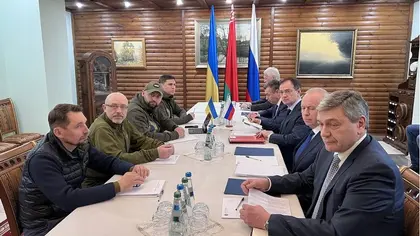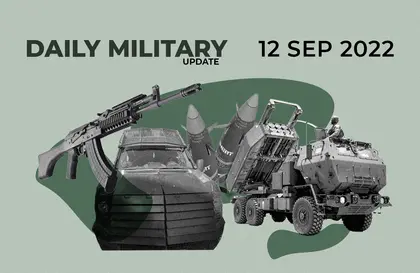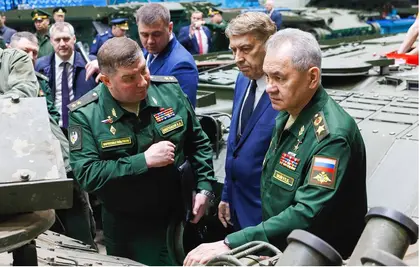Ukrainian troops have liberated dozens of villages and reached the border with Russia in Kharkiv Region, as Kyiv’s high-pace offensive rolled eastward on Monday, September 12, against reportedly weak resistance.
Images of tired but jubilant Ukraine Armed Forces (UAF) soldiers pulling down Russian flags to replace them with the yellow and blue Ukrainian flag emerged on the evening of Sunday, September 11 from the village of Lipsty, less than five kilometers from the Russian Federation (RF) border.
In the border rail nexus town of Volchansk, and the neighboring village of Kozacha Lopan, Russian forces had evacuated the village and heavily-armed “NATO troops” had taken full control of government buildings and road checkpoints, the pro-Russia Readovka Telegram channel complained. UAF statements said Ukrainian troops were still clearing the region of possible RF positions.
Ukrainian Defense Minister Oleksiy Reznikov said in Sunday evening television comments that advancing UAF columns have, in the last seven days, recaptured more than 3,000 square kilometers of formerly Russia-held territory and liberated more than 30,000 Ukrainian citizens living in more than 3,000 towns and villages. Most, located in far north-east Ukraine, had been under RF control for almost six months.
Ukrainian official and social media sources over the weekend told of chaos and confusion on roads leading eastward from the towns of Kupyansk and Oskil, and the city of Izyum, with Russian units fleeing.

Did Peace Between Russia and Ukraine Slip Through Their Fingers in April 2022?
An intercepted telephone call between two RF soldiers, one by his account deployed to positions intended to slow the Ukrainian onslaught, told of poor morale and UAF reconnaissance units infiltrating almost at will between weak RF defenses.
“They are really f*cking us up, they’re ahead of us, where our guys are, they’ve gone into our rear area between our own positions, they sneak through between the road checkpoints…they blow the f*ck out of one of our checkpoints, or they cross between, or across a river or some other place…for sure there’s a battalion of those (UAF) nationalists walking around,” one soldier said, according to the intercept made public on Monday, September 12 by the UAF Central Directorate of Intelligence (CDI).
On Saturday, September 10 the Kremlin announced that a “redeployment” of forces from the region would take place “refocusing” RF military assets in Luhansk and Donetsk Regions further east. An RF MoD statement said strategic priorities necessitated the shift, and that the transfer of men and machines eastward was disciplined and well-organized.
Hundreds of Ukrainian independent news reports and from-the-ground social media posts from UAF soldiers contradicted that Moscow narrative with a torrent of images and reports of RF soldiers – some having thrown away uniforms and put on civilian clothes – taken prisoner, RF combat vehicles captured on a wholesale scale and frequently in good running condition, and punishing UAF artillery strikes on columns of RF army vehicles attempting to escape encirclement.
A river crossing in the town of Oskil appeared to be one of the worst combat gauntlets faced by the Russians, with multiple videos appearing of drone-controlled UAF howitzers walking shells back and forth along RF army vehicle traffic jams attempting to cross the Oskil River.
A wave of RF missile strikes hit power stations in Kharkiv, Dnipro and Zaporizhzhia Regions on the evening of Sunday, September 11, plunging tens of thousands of homes into darkness and in Kharkiv, Ukraine’s second largest city, temporarily trapping civilians underground after trains of the Kharkiv metro stopped running. Most Ukrainian national news agencies said the strikes were Kremlin retaliation for Ukraine’s impressive military successes of the last week.
Electricity supplies were restored to 80% of Kharkiv users by mid-morning, said regional defense commander Oleh Sinehubov in a statement. The grid was up and operating again in Dnipro and Zaporizhzhia within hours of the RF missile strikes, other official sources said.
The military research group Oryx, an independent agency monitoring losses of both sides since the outset of the conflict, over the weekend counted as confirmed destroyed or captured by the UAF at least 150 RF major combat systems, including tanks, artillery, armored personnel carriers and anti-aircraft weapons.
According to the pro-Russia information platform Readovka, surrounded RF forces were still holding out in the town of Kupyansk, and a viable RF defense line was being built along the Oskil River line. According to multiple Ukrainian sources, UAF troops had already moved dozens of kilometers to the east, and since the break-through of RF lines last week encountered little organized RF resistance.
You can also highlight the text and press Ctrl + Enter






Comments (0)